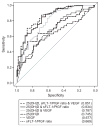Midgestation maternal serum 25-hydroxyvitamin D level and soluble fms-like tyrosine kinase 1/placental growth factor ratio as predictors of severe preeclampsia
- PMID: 21986503
- PMCID: PMC3600867
- DOI: 10.1161/HYPERTENSIONAHA.111.179069
Midgestation maternal serum 25-hydroxyvitamin D level and soluble fms-like tyrosine kinase 1/placental growth factor ratio as predictors of severe preeclampsia
Abstract
Recent studies have shown that low serum 25-hydroxyvitamin D (25[OH]D) level is a risk factor for preeclampsia. The clinical significance of in vitro findings that vitamin D regulates vascular endothelial growth factor production is unclear. We sought to determine whether there is an association between midgestation serum 25(OH)D levels and angiogenic factor activity and to compare their predictive value for the development of severe preeclampsia. We conducted a nested case-control study of women with severe preeclampsia (n=41) versus women with uncomplicated term birth (n=123) who had second trimester genetic screening (15-20 weeks). Using banked frozen serum, we measured levels of 25(OH)D, vascular endothelial growth factor, soluble fms-like tyrosine kinase 1, and placental growth factor and compared their correlations and predictive values. We found no correlation between serum 25(OH)D and angiogenic factors levels. 25(OH)D alone was comparable to vascular endothelial growth factor and soluble fms-like tyrosine kinase 1/placental growth factor ratio as a predictive marker for severe preeclampsia. A composite of both 25(OH)D level and soluble fms-like tyrosine kinase 1/placental growth factor ratio was more predictive than either alone (area under curve: 0.83 versus 0.74 and 0.67, respectively). In conclusion, combining midpregnancy 25(OH)D level with soluble fms-like tyrosine kinase 1/placental growth factor ratio provides a better prediction for the development of severe preeclampsia.
Figures


Similar articles
-
First trimester serum angiogenic and anti-angiogenic factors in women with chronic hypertension for the prediction of preeclampsia.Am J Obstet Gynecol. 2020 Apr;222(4):374.e1-374.e9. doi: 10.1016/j.ajog.2019.10.101. Epub 2019 Nov 6. Am J Obstet Gynecol. 2020. PMID: 31705883
-
Prediction of imminent preeclampsia at 35-37 weeks gestation.Am J Obstet Gynecol. 2019 Jun;220(6):584.e1-584.e11. doi: 10.1016/j.ajog.2019.01.235. Epub 2019 Feb 7. Am J Obstet Gynecol. 2019. PMID: 30738886
-
Plasma soluble fms-like tyrosine kinase 1 to placental growth factor ratio of 11.5 multiples of median predicts preeclampsia with severe features within 2 weeks of testing.Am J Obstet Gynecol. 2024 Sep;231(3):363.e1-363.e11. doi: 10.1016/j.ajog.2024.05.050. Epub 2024 May 31. Am J Obstet Gynecol. 2024. PMID: 38825028
-
Predictive value of the soluble fms-like tyrosine kinase 1 to placental growth factor ratio for preeclampsia in twin pregnancies: a systematic review and meta-analysis.Am J Obstet Gynecol MFM. 2024 Mar;6(3):101290. doi: 10.1016/j.ajogmf.2024.101290. Epub 2024 Feb 23. Am J Obstet Gynecol MFM. 2024. PMID: 38401234
-
[The role of angiogenic factors in preeclampsia].Orv Hetil. 2014 Nov 23;155(47):1860-6. doi: 10.1556/OH.2014.30042. Orv Hetil. 2014. PMID: 25403279 Review. Hungarian.
Cited by
-
Serum biomarkers combined with uterine artery Doppler in prediction of preeclampsia.Exp Ther Med. 2016 Oct;12(4):2515-2520. doi: 10.3892/etm.2016.3625. Epub 2016 Aug 29. Exp Ther Med. 2016. PMID: 27698752 Free PMC article.
-
Vitamin D and Inflammatory Cytokines in Healthy and Preeclamptic Pregnancies.Nutrients. 2015 Aug 4;7(8):6465-90. doi: 10.3390/nu7085293. Nutrients. 2015. PMID: 26247971 Free PMC article. Review.
-
Recent advances in the understanding of the pathophysiology of preeclampsia.Hypertension. 2013 Oct;62(4):666-73. doi: 10.1161/HYPERTENSIONAHA.113.00588. Epub 2013 Jul 29. Hypertension. 2013. PMID: 23897068 Free PMC article. No abstract available.
-
The association between preeclampsia and autism spectrum disorders among children: a meta-analysis.Korean J Pediatr. 2019 Apr;62(4):126-130. doi: 10.3345/kjp.2018.07010. Epub 2018 Dec 24. Korean J Pediatr. 2019. PMID: 30590001 Free PMC article.
-
Maternal Vitamin D Deficiency Causes Sustained Impairment of Lung Structure and Function and Increases Susceptibility to Hyperoxia-induced Lung Injury in Infant Rats.Am J Respir Cell Mol Biol. 2020 Jul;63(1):79-91. doi: 10.1165/rcmb.2019-0295OC. Am J Respir Cell Mol Biol. 2020. PMID: 32135073 Free PMC article.
References
-
- Sibai BM, Gordon T, Thom E, Caritis SN, Klebanoff M, McNellis D, Paul RH. Risk factors for preeclampsia in healthy nulliparous women: a prospective multicenter study–the National Institute of Child Health and Human Development Network of Maternal-Fetal Medicine Units. Am J Obstet Gynecol. 1995;172:642– 648. - PubMed
-
- Sibai B, Dekker G, Kupferminc M. Pre-eclampsia. Lancet. 2005;365:785–799. - PubMed
-
- Centers for Disease Control and Prevention. Maternal mortality: United States, 1982–1996. MMWR Morb Mortal Wkly Rep. 1998;47:705–707. - PubMed
-
- Silasi M, Cohen B, Karumanchi SA, Rana S. Abnormal placentation, angiogenic factors, and the pathogenesis of preeclampsia. Obstet Gynecol Clin North Am. 2010;37:239–253. - PubMed
-
- James JL, Whitley GS, Cartwright JE. Pre-eclampsia: fitting together the placental, immune and cardiovascular pieces. J Pathol. 2010;221:363–378. - PubMed
Publication types
MeSH terms
Substances
Grants and funding
LinkOut - more resources
Full Text Sources
Medical
Miscellaneous

